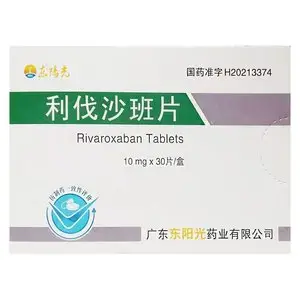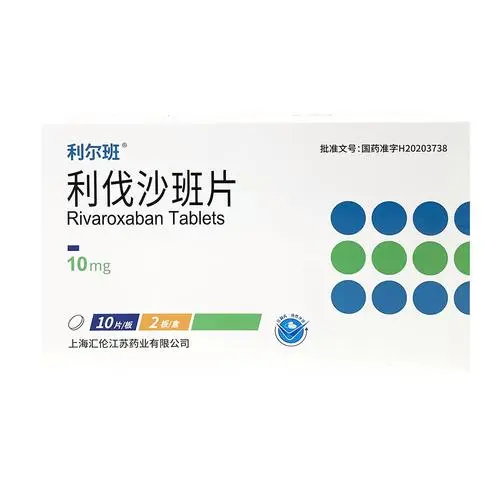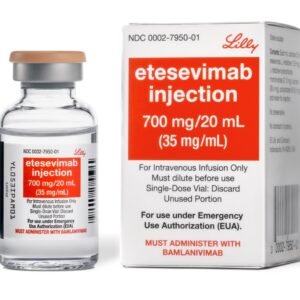Rivaroxaban
Function:
For the prevention of deep vein thrombosis (DVT) and pulmonary embolism (PE) in patients following hip and knee replacement surgery. It can also be used to prevent stroke and non-central nervous system embolism in patients with non-valvular atrial fibrillation, and reduce the risk of recurrence of coronary syndrome.
Dosage:
This product is in the form of tablets for oral administration. The 15 mg and 20 mg tablets should be taken with meals. The 10 mg tablets can be taken with or without meals. For adult patients with non-valvular atrial fibrillation to reduce the risk of stroke and systemic embolism: For those with Ccr>50ml/min, the recommended dose is 20mg once a day, taken with dinner. For patients with low body weight and advanced age (>75 years old), doctors may use 15 mg once a day at their discretion based on the patient’s condition. Please follow your doctor’s advice for details. For the treatment of deep vein thrombosis and pulmonary embolism: 15 mg, twice a day, with meals, for a total of 21 days, followed by 20 mg, once a day. Please follow your doctor’s advice for details. To reduce the risk of deep vein thrombosis and pulmonary embolism: 20 mg once daily with a meal. Please follow your doctor’s advice for details. For the prevention of venous thrombosis in adult patients undergoing elective hip or knee replacement surgery: The recommended dose is rivaroxaban 10 mg orally once daily. If the wound has stopped bleeding, the first dose of medication should be between 6-10 hours after surgery. For patients undergoing major hip surgery, the recommended course of treatment is 35 days. For patients undergoing major knee surgery, the recommended course of treatment is 12 days. When switching from warfarin to this product, start treatment with this product as soon as possible after the INR drops below 3.0 after stopping warfarin. Patients receiving other anticoagulants (such as low molecular weight heparin), when switching to this product, should start taking this product 0-2 hours before taking other anticoagulants in the evening; if continuous infusion of unstratified heparin is used, Take this product immediately after stopping heparin.
Adverse reactions:
Common adverse reactions are bleeding. Heart: Rarely tachycardia. Blood and Lymphatic System: Anemia (including corresponding laboratory parameters) is common; thrombocytosis (including elevated platelet count) is rare. Nervous system: syncope (including loss of consciousness), dizziness, and headache are rare. Gastrointestinal tract: Nausea is common; constipation, diarrhea, abdominal and gastrointestinal pain (including upper abdominal and gastric discomfort), indigestion (including upper abdominal discomfort), dry mouth, and vomiting are rare. Kidneys and urinary system: Renal damage (including increased blood creatinine and increased blood urea) is rare. Skin and subcutaneous tissue: Rarely pruritus (including rare generalized urticaria), rash, urticaria (including rare generalized urticaria), bruises. Musculoskeletal system: Rarely, extremity pain. Surgical complications: rare wound discharge. Blood system: common postoperative bleeding (including postoperative anemia and wound bleeding); rare bleeding (including hematoma and rare muscle bleeding), gastrointestinal bleeding (including gum bleeding, rectal bleeding, vomiting), hematuria (including hematuria) ), genital tract bleeding (including menorrhagia), hypotension (including drop in blood pressure, hypotension caused by surgery), epistaxis; internal bleeding in unknown key organs (such as brain), adrenal bleeding, conjunctival hemorrhage, hemoptysis. Systemic and administration site: Local edema, peripheral edema, discomfort (including fatigue, weakness), and fever are rare. Immune system: rare allergic dermatitis, hypersensitivity reaction. Hepatobiliary: rare liver function abnormalities and jaundice. During neuraxial anesthesia (spinal or epidural anesthesia), spinal or epidural puncture, patients receiving antithrombotic agents to prevent thrombotic complications are at risk for epidural or spinal hematoma, which may result in long-term or permanent Sexual paralysis. Postoperative use of epidural indwelling catheters or concurrent use of drugs that affect hemostasis may increase the risk of the above events. In addition, trauma or repeated epidural or renal column puncture may also increase the risk. Laboratory tests: Commonly elevated γ-GT, elevated transaminase (including elevated AST, ALT); rare elevated lipase, elevated amylase, elevated bilirubin, elevated lactate dehydrogenase, elevated ALP ;Rarely elevated conjugated bilirubin (with or without elevated ALT).
Drug contraindications:
If you are allergic to this product, it is contraindicated during lactation. It is contraindicated during pregnancy.
Share:
Products
Our offers
Health Classification
Let us work together to protect precious health































